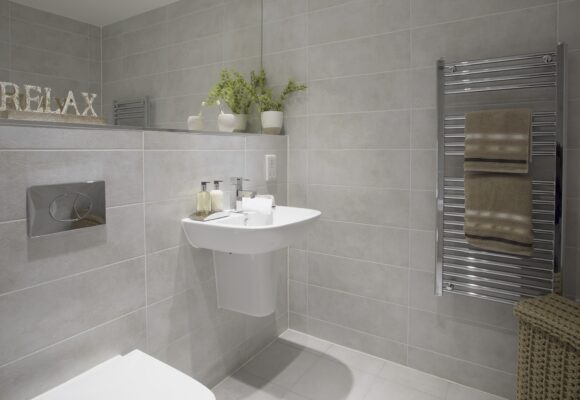In an era where electronics are omnipresent, from smartphones to outdoor lighting fixtures, ensuring their protection against environmental factors is crucial. One of the most common standards used for assessing the level of protection of electronic devices against intrusion from foreign bodies like dust and water is the Ingress Protection (IP) rating.
The IP rating system, developed by the International Electrotechnical Commission (IEC), provides a standardised way to quantify the degree of protection provided by a device’s enclosure. It consists of two digits: the first digit represents protection against solid particles, while the second digit represents protection against liquids. Understanding these ratings is essential for selecting the right electronic devices for specific environments, such as bathrooms and gardens, where exposure to moisture and other elements is common.
First Digit: Protection Against Solid Particles
The first digit of the IP rating indicates the level of protection against solid particles such as dust, dirt, and other foreign objects. It ranges from 0 to 6, with higher numbers indicating greater protection.
- IP0X: No protection against solid particles.
- IP1X: Protected against solid objects larger than 50mm (e.g., hands or large tools).
- IP2X: Protected against solid objects larger than 12.5mm (e.g., fingers).
- IP3X: Protected against solid objects larger than 2.5mm (e.g., tools and thick wires).
- IP4X: Protected against solid objects larger than 1mm (e.g., small tools and wires).
- IP5X: Dust protected. Limited ingress of dust is permitted but should not interfere with the operation of the device.
- IP6X: Dust-tight. Complete protection against the ingress of dust.
Second Digit: Protection Against Liquids
The second digit of the IP rating indicates the level of protection against liquids, including water and moisture. It ranges from 0 to 8, with higher numbers indicating greater protection.
- IPX0: No protection against liquids.
- IPX1: Protected against vertically falling droplets (e.g., condensation).
- IPX2: Protected against vertically falling droplets when tilted up to 15 degrees.
- IPX3: Protected against spraying water (e.g., rain) up to 60 degrees from vertical.
- IPX4: Protected against splashing water from any direction.
- IPX5: Protected against low-pressure jets of water from any direction.
- IPX6: Protected against high-pressure jets of water from any direction.
- IPX7: Protected against immersion in water up to 1 meter for 30 minutes.
- IPX8: Protected against continuous immersion in water beyond 1 meter. The exact depth and duration are specified by the manufacturer.
IP Ratings in Bathrooms
Bathrooms are high-moisture environments where water exposure is common. Therefore, it’s essential to use electronic devices with appropriate IP ratings to ensure their safety and longevity.
Lighting Fixtures
- Ceiling Lights: Ceiling lights in bathrooms should have a minimum IP rating of IP44 to withstand splashes of water from any direction. IP65 or higher is recommended for shower areas to ensure protection against water jets.
- Wall Sconces: Wall-mounted sconces should have a minimum IP rating of IP44 to protect against splashes of water.
Electrical Outlets and Switches
- Electrical Outlets: Electrical outlets in bathrooms should have a minimum IP rating of IP44 to protect against splashes of water.
- Light Switches: Light switches should have a minimum IP rating of IP44 to ensure protection against splashes of water.
IP Ratings in Gardens
Gardens are outdoor environments where electronic devices are exposed to various weather conditions, including rain, snow, and extreme temperatures. Therefore, it’s crucial to select devices with appropriate IP ratings to ensure their durability and performance.
Outdoor Lighting
- Path Lights: Path lights should have a minimum IP rating of IP44 to protect against splashes of water and dust ingress.
- Floodlights: Floodlights used in gardens should have a minimum IP rating of IP65 to withstand exposure to rain and other weather elements.
- Deck Lights: Deck lights should have a minimum IP rating of IP67 to ensure protection against water immersion and dust ingress.
Outdoor Electrical Outlets
- Electrical Outlets: Outdoor electrical outlets should have a minimum IP rating of IP44 to protect against splashes of water and dust ingress.
Garden Fountains and Ponds:
- Fountain Pumps: Fountain pumps should have a minimum IP rating of IPX7 to withstand immersion in water. IPX8 is recommended for deeper ponds and water features.
Outdoor Speakers
- Outdoor Speakers: Outdoor speakers should have a minimum IP rating of IPX4 to protect against splashes of water and dust ingress. IPX5 or higher is recommended for areas exposed to heavy rain or moisture.
Conclusion
In summary, understanding IP ratings is essential for selecting electronic devices suitable for specific environments such as bathrooms and gardens. By choosing devices with appropriate IP ratings, you can ensure their protection against dust, water, and other environmental factors, thereby prolonging their lifespan and maintaining optimal performance. Whether it’s lighting fixtures, electrical outlets, or outdoor speakers, selecting devices with the right IP ratings will help create safe, functional, and enjoyable spaces both indoors and outdoors.




 No products in the basket.
No products in the basket. 
